Excerpts from Jim Conrad's
Naturalist Newsletter
Entry dated December 30, 2023, issued from near Tequisquiapan; elevation about 1,900m, (6200 ft), ~N20.57°, ~W99.89°; Querétaro state, MÉXICO
"SPANISH NEEDLES," WITHOUT RAY FLORETS

Currently we're experiencing an ongoing two-year drought classified by the online North American Drought Monitor as a D3 Extreme Drought, after a rainy season that never developed. In the area's semiarid scrub, nothing is flowering, except for scattered, low-growing Sweet Acacias, with deep taproots. In non-irrigated cornfields in which the corn died when about knee high, and ranchlands, there's nothing. However, in a valley's alluvial floodplain, surrounding a little pond kept filled with pumped groundwater, and beside a tall planted eucalyptus tree shading the area most of the day, the above plant did blossom. Its earlier leaves apparently had been eaten off, or died for lack of rain; currently it was sprouting new leaves along with its flowering heads.
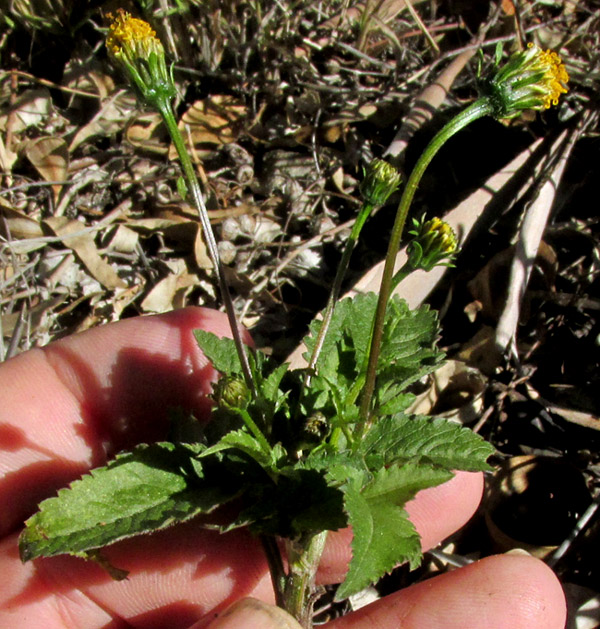
Each flowering head consisted of numerous yellow disc florets gathered inside a green, bowl-like involucre consisting of numerous scale-like phyllaries. This meant the plant belonged to the largest and most diverse of all plant families, the Composite/Aster/Sunflower Family, the Asteraceae. Each flowering head, or capitulum, stood atop a long, slender peduncle.

Identifying Aster Family plants, because of so many similar-looking species, can be hard. However, what's seen above narrows the possibilities tremendously. The key feature is that the green, scale-like phyllaries surrounding the yellow florets are arranged in two distinct series. Phyllaries of the outer, lower series are widely spaced, darker green and slenderer than those of the inner series, which are overlapping, paler and broader. Relatively few genera produce phyllaries in two series. Probably the most commonly encountered are Cosmos, known to gardeners as cosmoses, and Bidens, which includes several species of wildflowers and weeds known by many names.
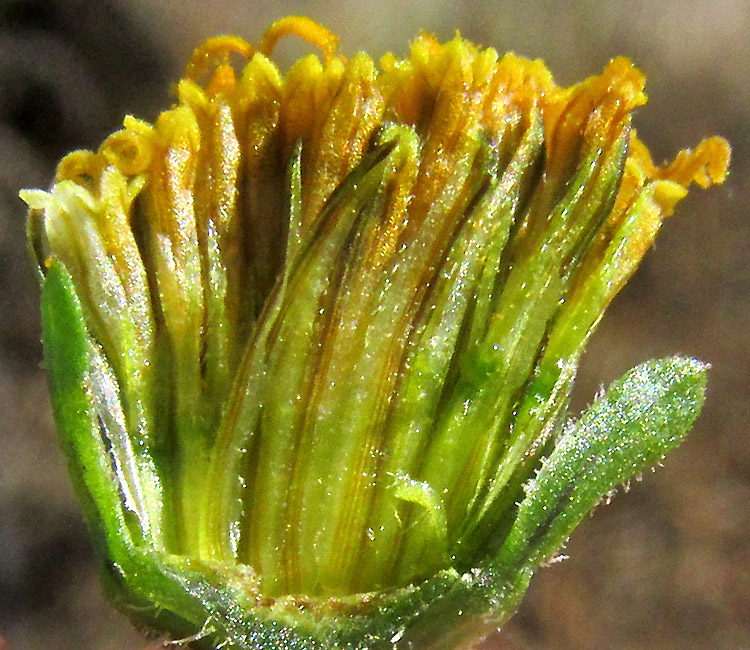
Above, also important to note for identification is that within the involucre, slender, scale-like paleae separate the lower parts of disc florets from one another. Many Aster Family genera produce no paleae at all. Also, near the left edge of the above photo, where green floret bottoms join to yellow corolla tubes above them, note the white items coming to a point. Those are future spine-like awns, which will stick into rabbit fur and the like, for seed dissemination. That's this species' pappus, of which many variations are possible, including not existing at all, so also it's an important feature for identification. However, both Cosmos and Bidens, which are very closely related genera, display such features.

At the right, there's something remarkable. On just one capitulum, at the edge of the cluster of yellow disk florets, there's that tiny white item. That's a rudimentary white corolla of a petal-like ray floret that didn't develop. In fact, if you return to the upper photos, including the one immediately above, along the capitula's margins appear other arrested-growth white ray florets, even less developed.
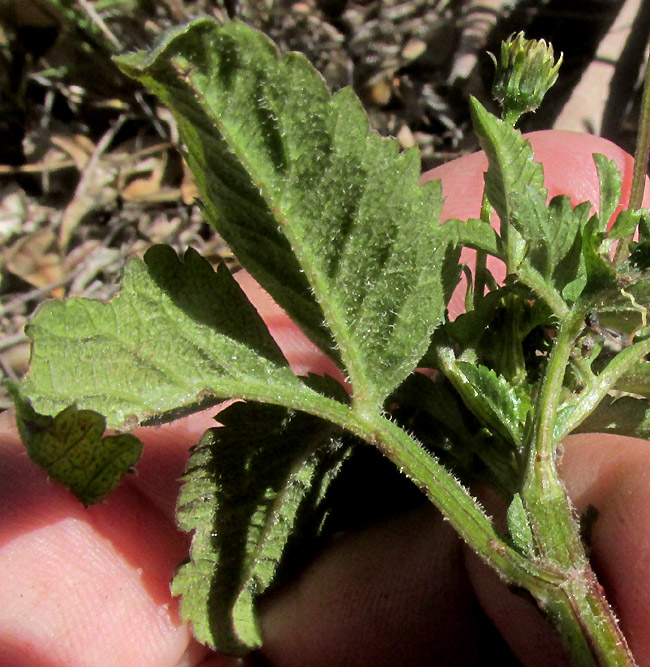
Above, a compound leaf comprising three leaflets is soft-hairy on its undersurface. At the picture's lower, right corner, notice the squared stem below the petiole.
All the above-mentioned features lead to our two commonly occurring genera, Cosmos and Bidens. Since already I've encountered Bidens species without ray florets, first I looked into that genus. In this part of upland Central Mexico, if you have a Bidens without ray florets, or only hints of them as in our case, and the involucre consists of more than five lower or outer phyllaries, you have BIDENS PILOSA; image comparisons of expert-identified plants confirm the ID.
This species occurs in warm and hot areas nearly worldwide. It's native American, originally native from Texas in the US south into most of South America. Also it's an invasive weed, often growing in abundance, in parts of Africa, western Europe and southern Asia. It's known by so many English names that it's impossible to choose which is the most commonly used. Kew's Plants of the World Online database states flatly that our plant is called Black Fellows, though I've never heard that. Wikipedia's Bidens pilosa page mentions the names Hitch Hikers, Black-jack, Beggarticks, Farmer's Friends, Spanish Needle, Shepherd's Needle, and Cobblers Pegs, adding that the latter is the mostly commonly used name, though I've never heard of that one, either. Here I'll call our plant Spanish Needles because that's what I first learned from books. My family in Kentucky called them Stick-Tights.
Distributed over such a wide area, it's not surprising that its taxonomy has long been uncertain. Kew's Plants of the World Online mentions 78 synonyms now all regarded to be Bidens pilosa, which was first named by Linnaeus himself in 1753. A very similar species, but bearing conspicuous white ray florets and now generally known as Bidens alba, has been regarded as a variety of our Bidens pilosa. It's interesting to compare those two taxa.
The 2008 Flora del Bajío treatment of Bidens pilosa says that various authors think of the taxon as a species complex, which indicates that boundaries between the very closely related species aren't clear. I find no more recent literature clarifying the situation. The Flora del Bajío considers the species as only sometimes producing white ray florets, five in number. However, an Internet image search for the species results in photos overwhelmingly portraying flowers with large white ray florets, often numbering more than five.
Perdue University's "Famine Foods" section features Bidens pilosa, reporting that in several African countries the leaves are eaten boiled, usually discarding the water. In Zambia the roots are reported as eaten, probably after prolonged boiling.
The online Atlas de las Plantas de la Medicina Tradicional Mexicana, which names our plant mozote, and mentions ñadoni as the name used by Otomí speakers in our area, gives a long list of traditional medicinal uses for the species in Mexico. It says that as early as the 1500s the Spanish Franciscan friar Bernardino de Sahagún wrote that the herb could be ground and made into a plaster to be applied to swollen nipples. Eat the ground herb for good digestion, plus it is diuretic and refreshing. Cook to make a tea for reducing fever. During the 1800s and early 1900s, the Mexican National Medical Institute reported its usefulness against diabetes, and to promote urination. Today, many people regard it almost as a cure-all.
Maybe there's something to all these uses. The 2017 study by Garima Singh and others entitled "Pharmacological potential of Bidens pilosa L. and determination of bioactive compounds using UHPLC-QqQLIT-MS/MS and GC/MS" found that an extract from our plant killed a significant percentage of a certain kind of cancerous cell. The authors concluded that "... the leaf extract of B. pilosa might be a good candidate for the search of efficient environment friendly natural bioactive agent and pharmaceutically important compounds."
With regard to the missing white ray florets, it may be interesting to note that flowers without petals usually are interpreted as representing an evolutionary transition from animal pollination (usually insect) to wind pollination. Such petal-less flowers typically compensate for not using animal pollinators by producing much larger amounts of pollen to be dispersed widely by wind. Our plant still produces pollen in its disc florets, so it's not the same thing. Still, seeing how evolution compensates for losing attention-getting petals, one wonders whether our plant might in some way compensate for losing its pollinator-attracting white ray florets. Possibly the main compensation is that Bidens pilosa over much of its distribution can be flowering year round.
Entry dated November 10, 2023, from notes taken from ridge with secondary oak forest about 300m west of Cascadas de La Piedad waterfall 3kms NW of the community of San Pablo, municipality of Almeaco de Bonfil; N20.1002°, W100.0067°, elevation 2360 meters (7750ft); extreme southern Querétaro state, MÉXICO
BIDENS PILOSA WITH PETALS
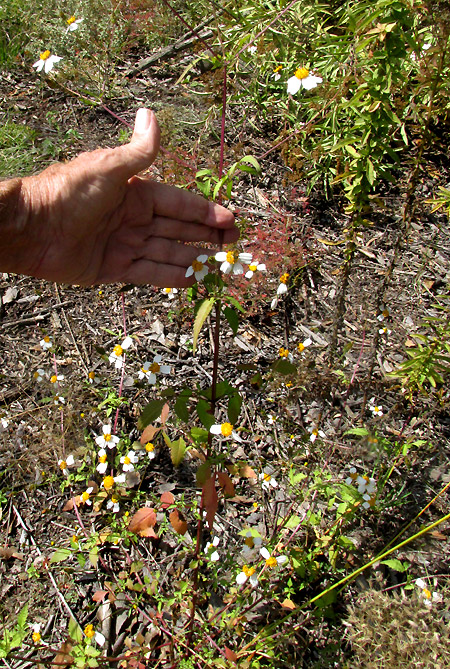
At the edge of an abandoned field next to a woods, the above wildflower displayed its vigor by thriving during a continuing two-year period classified by the North American Drought Monitor as a D3 Extreme Drought.
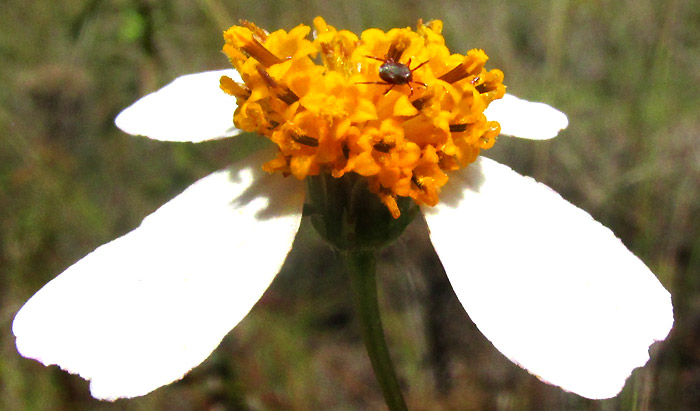
Its flowering heads were composed of yellow-orange disc florets and white ray florets.
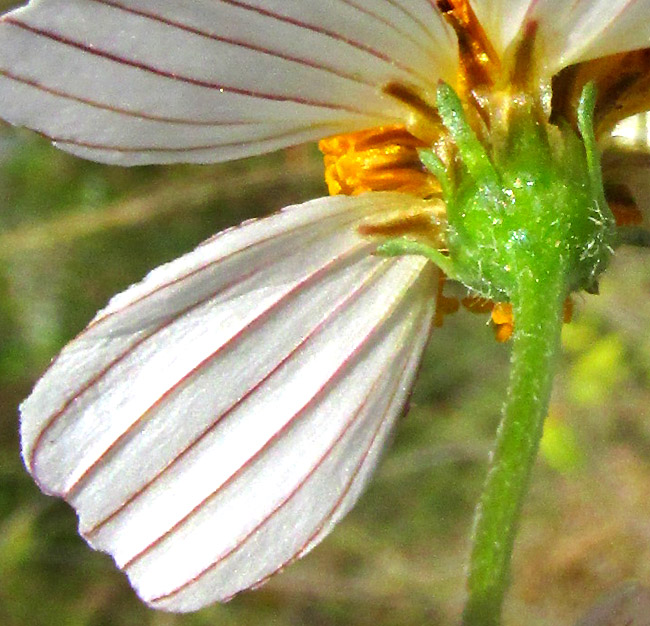
Seen from below, the ray florets' white corollas displayed several dark-pinkish longitudinal veins.

The green involucre consisted of two distinct series of bracts, or phyllaries, and was white-hairy on the lower part.
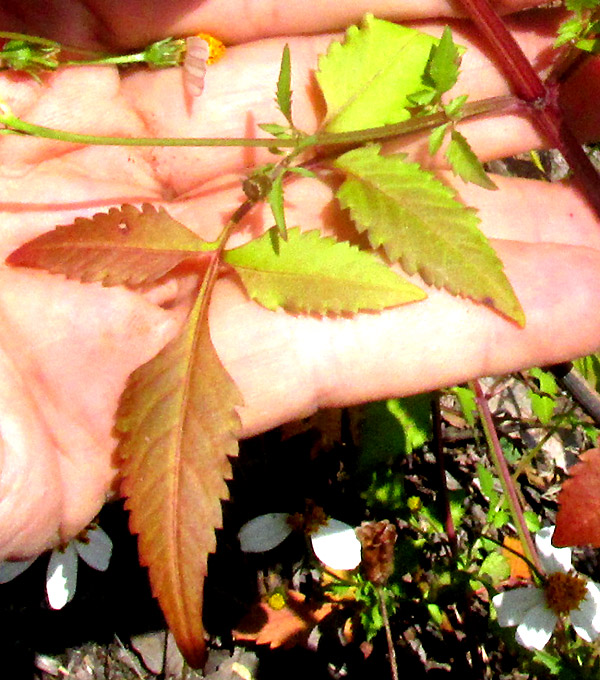
The compound leaves were turning yellow, then rusty reddish.
This is the form of Bidens pilosa producing conspicuous ray florets with white corollas.
Some would say that our plant could as well be Bidens alba, and I find no solid reason to dispute that. Currently Kew's Plants of the World Online database accepts the name Bidens alba, but certain other authoritative sources don't. The online Flora of North America lumps Bidens alba with our Bidens pilosa, referring to a Bidens pilosa complex of variously named species, and with my experience to date, I'm now agreeing with that. The MalezasdeMexico (Mexican Weeds) website points to differences between the two species but then adds that usually the differences can't be seen in each individual plant -- "Generalmente no se puede diferenciar cada individuo." The Flora del Bajío documenting this area's Bidens species documents Bidens alba in Querétaro state's northern part, the Eastern Sierra Madres, but finds Bidens pilosa generally scattered throughout.